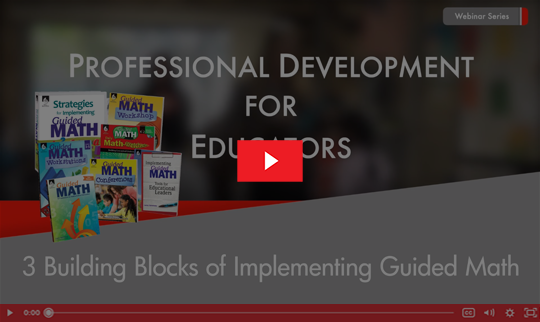5 Tips to Maximize Guided Math Instruction
Whether you are thinking about trying Guided Math in your classroom or are reflecting on how you might fine-tune the way you now use Guided Math, this article offers tips to make the most of the Guided Math framework. Learn more about the components in the Guided Math framework with a free downloadable infographic.
Understanding Guided Math
Guided Math is a research-based strategy that helps teachers create an environment for mathematics that supports learning and fosters mathematical thinking and understanding. Guided Math invites teachers to engage their classrooms, to assess students' problem-solving abilities, and to utilize small-group and whole-group instruction, manipulatives, math warm-ups, and math workshops to engage students in connecting mathematics to their own lives. Guided Math provides a structure for teaching mathematics as teachers focus on a specific strategy, skill, or concept. Differentiation is a key component as teachers focus on the development of each child at increasing levels of difficulty.
Maximizing Guided Math
These five tips will help you make the most of the guided math framework in your classroom, whether you are already using Guided Math or will begin to implement it.
Include 7 Components
The seven components of Guided Math are as follows: an environment of numeracy, math warm-ups, whole-class instruction, small-group lessons, math workshop, math conferences, and assessment. Include all seven of the Guided Math components in your math instruction. While small-group lessons and Math Workshop are hallmarks of the Guided Math framework, all of the components when used together enhance mathematics instruction and help maximize student learning. Take time to reflect on your math block. Which of these components are already a part of your students’ daily routine? What can you do to build all of them into your classroom instruction?
Offer Equitable Instruction
While providing equal instruction means teaching each and every student the same lesson, equitable instruction calls for lessons that offer all students what they need to be successful—constantly adjusting teaching in response to students’ immediate strengths and needs. Use Guided Math to offer all students equitable rather than equal instruction.
Guided Math gives you the tools you need to discover precisely what your students know and can do and then to flexibly plan and teach lessons that target their immediate learning needs, thus shifting away from one-size-fits-all instruction.
Develop Ongoing Assessment
Develop an ongoing formative assessment system that gives you the information you need to plan effective instruction. The system doesn’t have to be very time consuming. For example, keep anecdotal notes to document what you observe during small-group lessons. Or, try using brief exit tickets the day prior to a lesson to determine if any students have gaps in the prerequisite knowledge and skills they need to be successful with that lesson. Having this information at hand allows you to form groups of students who have similar learning needs and to target those needs.
Consider the GUIDE Workshop Model
Consider using the GUIDE model for Math Workshop. With the GUIDE workshop model, students work in just one workstation a day—completing all five stations in a week. This works because each workstation includes multiple tasks—some compulsory, some optional. Eliminating the rotation of students from station to station during a math block allows you to vary the amount of time you spend with students for small-group lessons. Assign students to work independently in heterogeneous groups at math workstations, but then meet with homogeneous groups for small-group lessons designed to address their specific learning needs. GUIDE workstation tasks do not need to be changed weekly. Because students work on a workstation game or task only one day during the week, those that are worthwhile and appropriate for students’ learning needs can remain in the workstation until you decide to replace them with other tasks that better support instruction or until your students tire of them.

Reinforce Content with Workstation Tasks
Plan workstation tasks to reinforce the mathematical content that students have already mastered, to promote computational fluency, or to offer opportunities for mathematical investigations. Avoid including tasks that require students to use the mathematical content they are currently learning. Before assigning tasks, be sure students have mastered the content sufficiently to be able to complete them independently, with accuracy, and without considerable confusion. Making use of math workshops for ongoing practice of the content students have already learned firmly plants it in their permanent memories and deepens their understanding. This reduces the need for later extensive review prior to high-stakes testing.
Also, use this time to challenge your students with tasks that help them develop strategies to improve their computational fluency. These tasks offer students much needed practice but can be completed successfully by students as they work independently.
Another type of task you might choose to include in workstations is the investigation of math-related issues. For example, a task might involve simple research on a mathematical topic; the gathering, display, and analysis of data; or real-life problem solving. Simple questions can inspire students’ mathematical thinking, such as How many different shapes can you see in the classroom? What is the most efficient way to seat students as they come into the lunchroom? What jobs require people to be able to find the area of a surface? Who is your favorite mathematician and why? Students can successfully complete these kinds of tasks independently. Following these guidelines when planning math workstation tasks minimizes off-task behaviors, incorrectly completed work, and the interruption of small-group lessons by students who are unsure of what they are asked to do.
By including the seven components of Guided Math, providing equitable instruction, developing ongoing assessment, and leveraging the workshop model and workstation tasks, you will be able to maximize Guided Math instruction in your classroom. Watch students grow in achievement and confidence as mathematicians as you make the most of this research-based framework.
Author Bio:
View All AuthorsLaney Sammons, M.L.S., Author and Mathematics Consultant
Laney Sammons, M.L.S., is an instructional coach and former elementary school teacher. During her 21 years of working in classrooms, she developed the Guided Math framework to support the diverse learning needs of her students. As a mathematics consultant, she trains teachers and educational leaders to use this framework and has presented at National Council of Teachers of Mathematics conferences. Laney has also authored several other books including Strategies for Implementing Guided Math and...
Join the TCM Blog Community
Subscribe by sharing your email address and we will share new posts, helpful resources and special offers on the issues and topics that matter to you and the children and teens you support.

